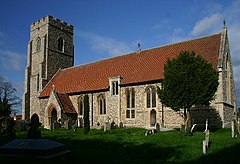Freckenham
| Freckenham | |
|---|---|
 St Andrew's, Freckenham |
|
| Freckenham shown within Suffolk | |
| Population | 344 (2011) |
| OS grid reference | TL664720 |
| District | |
| Shire county | |
| Region | |
| Country | England |
| Sovereign state | United Kingdom |
| Post town | Bury St Edmunds |
| Postcode district | IP28 |
| Dialling code | 01638 |
| EU Parliament | East of England |
Freckenham is a small rural village located in Suffolk, East Anglia, in the country of England.
Geographically, it is relatively flat and has the River Kennet, a tributary of the River Lark locally known as the Lee Brook, cutting through the centre of the village. The parish's boundary forms, on its west and south sides, the boundary between Cambridgeshire and Suffolk.
The village's name is listed as "Frekeham" in 895, and appears in the Domesday Book as "Frakenaham". The name is believed to mean "homestead of a man called Freca", or derive from frecena a Saxon word meaning "the home of strong men or warriors".
The parish of Freckenham has been inhabited since neolithic times; a flint axe was unearthed in the village in 1884. With fens on three sides, early residents completed their defense by raising earthworks that are believed to have originally reached perhaps twenty feet in height. The remains can still be found in the field by the church, and Beacon Mound that was used to relay messages in medieval times was added as part of them in c.14th century.
The hoard of around 90 Iron Age gold coins dating from about AD 20 that was found in the area of Mortimer's Lane suggests that the village lay within the territory of the Iceni tribe. Many of these well-preserved coins are now housed in the British Museum. It is probable that Romans also occupied the area, and the celebrated Mildenhall Treasure were found only a few miles away. During the Dark Ages the village may well have witnessed any of the many Saxon raids on the region and may be the origin of the many bones buried near the church.
The first written record of the village dates from 896 when Alfred the Great gave "Freckenham in the County of Suffolk and my small estate in Yselham (Isleham)" to Burricus, Bishop of Rochester. In the tenth century the conquering Vikings sold the village, but it was restored to Rochester only to be lost again when Sweyn Forkbeard invaded and is believed to have destroyed the village's castle, of which only the motte mound remains. When the Vikings were finally expelled in 1046 the parish passed to Harold Godwinson and in 1066 to Odo of Bayeux brother of William the Conqueror.
...
Wikipedia

